Abstract
Cosmic rays interact with fields and background radiation as they propagate in space, producing particle cascades of various sizes, shapes and constituents. The potential observation of at least parts of such phenomena, referred to as cosmic-ray ensembles (CRE), from Earth would open a new channel of cosmic-ray investigation, since it might be a manifestation of fundamental symmetries of nature. Research dedicated to CRE is one of the main scientific objectives of the Cosmic-Ray Extremely Distributed Observatory (CREDO) Collaboration, and with this article we address one of the cornerstones of the relevant scientific program: the simulation method dedicated to CRE studies. Here we focus on CRE resulting from synchrotron radiation by high energy electrons as one of the most prevalent energy loss processes. Providing the example of simulation output analysis, we demonstrate the advantages of our approach as well as discuss the possibility of generalization of current research.
1. Introduction
The nature of ultra-high energy cosmic rays (UHECR; eV) has not been completely understood yet, and thus remains among the most important problems of modern astrophysics. There is a lack of convincing agreement both on the possible UHECR sources and on their origination mechanisms [1]. Theoretical efforts to unveil the mystery of UHECR origin circulate around two main approaches. According to the classical one, often referred to as “bottom-up”, charged particles are accelerated [2] up to ultra-high energies (UHE) at some groups of astrophysical objects (e.g., [3,4]), powerful enough to transfer the highest energies detected to cosmic ray particles. The most plausible UHECR accelerators are gamma-ray bursts, shock wave structures at active galactic nuclei, jets of radio galaxies, etc. (see, e.g., [5,6,7] and references therein). The opposite view is represented within theoretical, “top-down”, scenarios, which rely on the existence of exotic super-heavy matter and its interactions resulting in the formation of lighter particles within UHE range [8,9,10,11]. Remarkably, neither approach rules out photons as UHECR, even though the approaches significantly disagree about their fraction in the total UHECR flux, from few percent in the acceleration models [12] to approximately a half otherwise [13]. New physics, e.g., Lorentz invariance violation [14,15,16], could be another UHE photons relied test, since one of its predicted consequences is the growth of the photon mean free path which should obviously lead to the photon flux increase. For the time being, no detection of UHECR photons has been reported by the main experiments, which sets up quite stringent limits almost excluding top-down models under some additional assumptions [17,18]. This yet unexplained discrepancy between experimental data and theoretical expectations makes the puzzle of UHECR photons existence not only challenging and exciting, but also extremely important for current astrophysics. However, the current treatment of UHECR photons non-registration could be imprecise, since it extrapolates low energy interaction models on the UHE domain, which might lead to misinterpretation of experimental data. One of the possible ways to explain the absence of registered UHECR photons is their negligible chances to reach the Earth due to interactions with fields, radiation and matter while propagating in space. Indeed, such processes inevitably result in generation of particle cascades, discussed, for example, in [19,20,21], etc. Such cascades are hereafter referred to cosmic-ray ensembles (CRE), and can differ by size, shape and constituents, correlated spatially and/or temporarily. Since recently, such phenomena became a key scientific interest of the Cosmic-Ray Extremely Distributed Observatory (CREDO) collaboration [22,23,24].
The main motivation of CRE-oriented research is its potential contribution to cosmic-ray astrophysics because it could complement the up-to-date approach, aimed at detection and analysis of individual cosmic rays. By contrast, the progress in the study of cosmic rays, correlated on global scales, attempted mostly by educational arrays (for instance, [25,26,27,28]), is slower mostly because of hardware requirements (need for detector array significantly larger than already existing ones). For obvious reasons the development of a new detector of the global size from scratch seems to be unfeasible in the nearest future; thus, a natural way to overcome this issue is organizing already existing detector arrays and individual devices, regardless of their type and size, into a widespread network for a joint data analysis. Some promising ideas about the CREDO observational infrastructure along with preliminary results obtained with its already operating elements are discussed in, e.g., [29,30,31,32].
In the present paper we propose a method of simplifying the processing of CRE simulation results in order to estimate the physics parameters favorable for potential observation of at least part of a CRE in terrestrial conditions. While simulating the formation of particle cascades, at the current research stage we limited ourselves to synchrotron radiation, since this process is inevitable in every astrophysical environment. For general reasons we chose UHE electrons as the primary particles, assuming they are either accelerated up to their energies or arise in pair production acts by UHE photons. We illustrate the capabilities of our method with the analysis of an example simulation run and argue that our approach to the particle cascades simulation could be useful and informative in the CRE-oriented research.
2. Materials and Methods
We performed our simulations of primary UHE electrons propagation in a galactic magnetic field using CRPropa (version 3.1) [33,34], an open access transport code, written in C++ programming language and interfaced with Python, with the latter being a recommended option for steering. It is designed as a toolkit providing the user with a number of modules which could be called with a steering card. Each module implements a separate aspect of simulation (sources, propagation, interactions, fields, observers, etc.). The modules (including self-written) could be combined in accordance with a particular task (see the details and examples at the official web page [35], where one can also find the code itself along with installation instruction).
We aimed at tracking the secondary particles down to energies as low as 1 GeV, the value corresponding to the capabilities of computational resources available (the limitations grow proportionally to the number of secondary particles, which, in turn, depends on the energy range between the primary and the product particles). In case of synchrotron radiation as the leading process of CRE origination, the secondary particles we are interested in are synchrotron photons.
We developed an algorithm, later referred as the “CRE-Pro” script, which allows to skip tracking of photons with CRPropa or another code designed for simulation of cosmic ray motion. Since synchrotron photons in the majority of cases propagate linearly, there is no need to track down every photon emitted within the simulation, which makes it possible to dramatically reduce the amount of computing resources. Synchrotron emission occurs while charged particles propagate in the electromagnetic fields, hence a natural way to calculate the particle trajectories is solving the differential equations of motion using iterative methods (see, e.g., [36] and references therein). The resultant trajectory of a particle is an approximation of a sequence of propagation steps. The method we introduce in this paper relies on the assumption that all the electrons emitted along a single propagation step are distributed within a localized area of an observer surface, forming, in a sense, the projection of the step onto this surface (Figure 1).
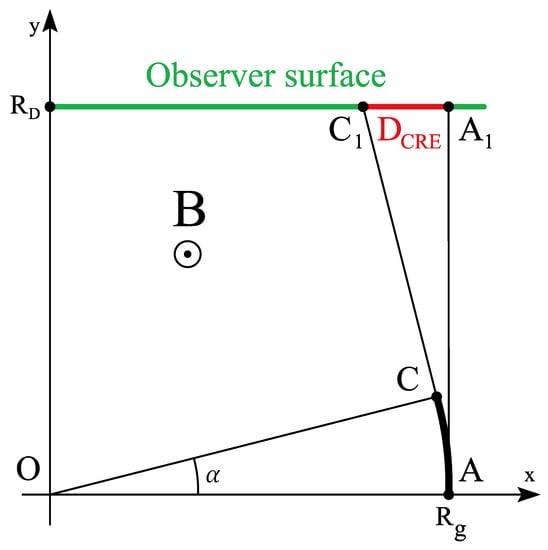
Figure 1.
Geometrical interpretation of the idea behind CRE-Pro script. Synchrotron photons emitted along the propagation step of the electron, propagating in a transverse magnetic field B, are confined within region of size of the observer surface, located at a distance from the starting point. The propagation step has angular size , is the initial gyroradius of the electron trajectory.
Consider an electron with the starting energy E propagating in a magnetic field with the transverse component value B. Since the motion of the electron is influenced by the Lorentz force, its trajectory usually looks like a spiral of variable curvature defined by its gyroradius
where m is electron mass, q is its electric charge, is its Lorentz factor and is its rotational velocity. Thus, the angular size of a propagation step with the length (AC arc in Figure 1) is
We assume that synchrotron photons propagate along the straight lines tangent to the electron trajectory at the points of emission. Therefore, such lines at the beginning and at the end of a single propagation step define the edges of the step projection onto an observer surface. The latter can be chosen arbitrary to match the geometry corresponding to certain physics conditions. In this paper we limit ourselves to the simplest observer surface, a plane. Such a simplification is acceptable in the majority of cases important for CRE studies, because the observer is usually located far enough from the region synchrotron emission is simulated in.
Within this approach we place the observer plane at a distance from the beginning of the propagation step perpendicularly to the tangent line at this point (Figure 1). The size of the step projection, , as a function of , B, and E can be derived using the following geometrical considerations. Suppose the electron trajectory is completely contained within the XY plane. The Cartesian coordinates of the starting point A of the step and its ending point C in the chosen coordinate system are, respectively, (, 0.0), and (, ). The edges of the step projection onto the observer plane are, correspondingly, (, ) and (, ), so that
Physics parameters, namely the electron energy E and magnetic field B, vary along a small part of the electron trajectory such as a single propagation step. Thus, an extra discussion is needed in order to treat the value we calculate, the step projection , in a proper way. The CRPropa code used for the simulation of electron motion account neither for the energy loss caused by the synchrotron emission of every single photon nor for trajectory gyroradius changes along the step. Correspondingly, only the energy values at the ends of propagation steps are stored, while the simulated photons are assigned with the momenta equal to that of their parent electron. As far as the magnetic field is concerned, its changes along a single propagation step are not likely to be significant since the step sizes (fractions of a parsec) are usually much smaller than coherence length values in the galactic magnetic field models (tens of parsecs). Still, CRE-Pro allows for excluding the steps with abrupt changes of the magnetic field out of the analysis. However, we choose the largest magnetic field value along a single step as well as the energy at its end, i.e., the minimal energy along the step, to calculate the lower limit for the trajectory gyroradius, and thus the upper limit for the step projection onto the observer plane.
3. Results
In this section we present some results drawn from the analysis of an example simulation run in order to prove the concept of CRE-Pro use for the CRE-oriented studies. The initial physics conditions used for the CRPropa simulation of electron propagation are listed below:
- The primary electron energy is 3.981 EeV
- The starting point of the primary electron is the Galactic center, the origin point of the galactocentric coordinate system, (0.0, 0.0, 0.0)
- The initial direction of the primary electron is (−1.0, 0.0, 0.0) (towards the Solar System)
- The galactic magnetic field is described by the JF12 model [37]
- The minimum energy threshold is 10 PeV
- The synchrotron radiation threshold is 1 GeV
The estimation of chances to register at least a part of a CRE on the accessible observer surface with already existent or only planned detector arrays requires precise knowledge of spatial distribution of the CRE constituent particles. By skipping the propagation of synchrotron photons within CRPropa for the purposes described above, we lose precise information on their distribution over the observer surface, knowing only the exact locations of their emission points along the propagation step. Thus, the distribution of photons along the step projection should be introduced artificially, since it is crucial for estimation of CRE observation conditions, including the most extreme, and therefore, intriguing case of two photon CRE. We limited ourselves with two cases of photon distribution over an observer surface. The first of them, equidistant distribution of photons, is considered to provide information on an average, in a sense, two-photon CRE.
Provided N photons are emitted along the propagation step (we sorted out all steps with less than two photons generated, analyzing only those logically related to the definition of a CRE; there are 592 steps meeting this condition () in the chosen example), we calculated the observer distances from the photons emission region for which 2 adjacent photons on the step projection are located at a distance not exceeding the Earth size (from now on in the text this value is denoted as ). For the equidistant distribution of N photons we used the condition
by meaning the size of the step projection (Figure 1).
After inserting this condition into Equation (3), one obtains
The resulting distribution of is shown in Figure 2.
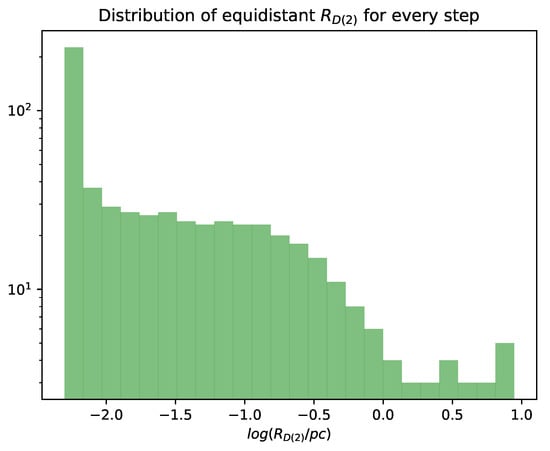
Figure 2.
The largest observer distances for the “equidistant” photon distribution; every entry corresponds to a single propagation step with emitted photons (592 in total); the minimal and maximal values plotted are 0.005 pc and 8.835 pc, respectively.
Within another model of synchrotron photons distribution we considered proportionality of corresponding distances between the photons emission points and their projections on the observer surface was preserved. Such an approach, lately referred to as proportional, can also treat the real distribution of synchrotron photons improperly since the energy of the parent electron does not reduce at a constant rate due to different energies of the photons emitted. However, this assumption is more realistic than the equidistant distribution of photons discussed above.
As far as we assume that all emitted photons reach the observer surface, we can also skip the calculation of the photons’ exact positions at the latter, keeping in mind that the distance between any photons at the observer plane forms the same fraction of the whole step projection length as the ratio of the distance between correspondent emission points to the step length. Thus, we calculate the distance between every pair of neighbouring photons provided the distance between their projection points equals the Earth size (extreme case of the two-photon CRE observation), and from the proportion
where is the distance between the i-th and the (i+1)-th photons, obtain
In order to follow the logic of parameter choice discussed above we use the value of the parent electron energy at the end of the whole propagation step whereas among two values of magnetic field, extracted at the emission points of the photons, the largest one is chosen; thus, the computation of the low limit value is ensured. Since within the proportional approach each pair of adjacent photons is being processed, potential changes of the magnetic field during a fraction of the step could be neglected, because they are not likely to occur. As a result, for every propagation step containing N emitted synchrotron photons we calculate observer distances using (7). The largest of them represents the most optimistic for our research case in terms of a two-photon CRE potential observation at the Earth-sized surface.
The distribution of for the whole example run is presented in Figure 3 (the “proportional” case) whereas both considered approaches are compared in Figure 4. Every entry on these histograms corresponds to a single propagation step of the parent electron.
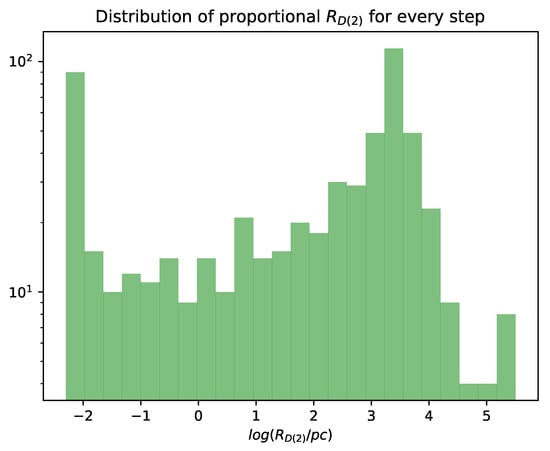
Figure 3.
The largest observer distances for the “proportional” photon distribution; every entry corresponds to a single propagation step; the minimal and maximal values plotted are 0.005 pc and 317.336 kpc, respectively.
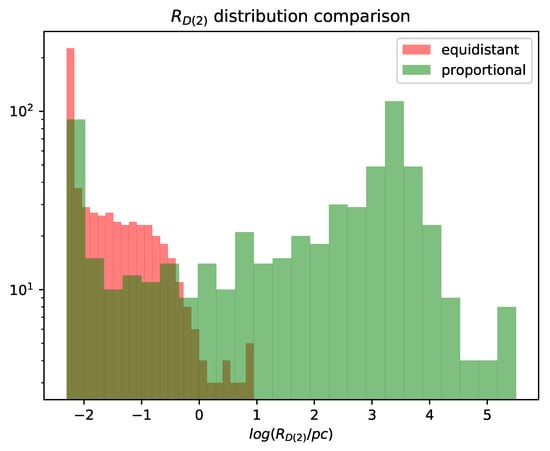
Figure 4.
The largest observer distances compared for “equidistant” and “proportional” photon distribution models; every entry corresponds to a single propagation step.
Note that the abundance of entries in the lower bin of distributions plotted in Figure 2, Figure 3 and Figure 4 is related to a significant number of steps with very few photons generated, which results in low calculated values of . This result is in a sense not physical and should be ignored, but we presented these plots unchanged for illustrative purposes, to account for all the steps which formally meet the definition of CRE ().
As one can deduce from the comparison of the two models of photon distribution over the observer surface (Figure 4), the proportional approach results in expectations that are orders of magnitude more optimistic regarding the distances from the emission region at which the separation of two photons at the observer does not exceed the Earth size.
We calculated observer distances for each pair of adjacent photons emitted along a single propagation step of the parent electron. The resulting distributions are presented for several steps in Figure 5a–f along with the value of the corresponding observer distance computed for the equidistant approach (vertical red lines). Extended information on the physics parameters extracted from the simulation output for a particular step is listed in Table 1.
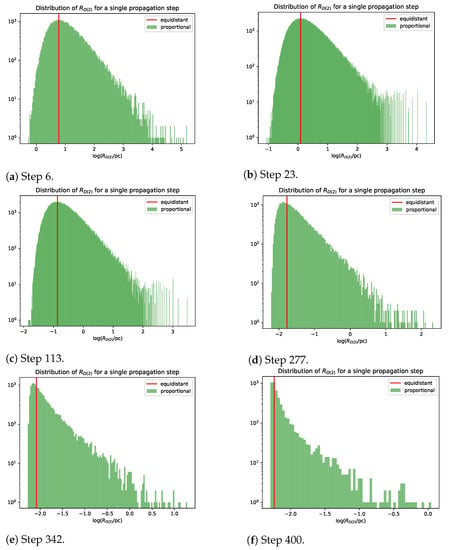
Figure 5.
The largest observer distances distribution for every pair of adjacent photons emitted along a particular step.

Table 1.
Information on proportional and equidistant distribution of photons over the observer surface for electron steps, plotted in Figure 5a–f.
As it follows from the comparison of the respective data and plots, the propagation steps corresponding to the higher values of the electron energy are more likely to produce a two-photon CRE on the higher observer distances, which leads to expansion of the horizon for its potential observation in the Earth-sized conditions. Such a conclusion is, in general, consistent with geometry resulting from the physics of a charged particle propagation in the magnetic field. Indeed, smaller opening angles which separate a pair of synchrotron photons correspond to larger trajectory gyroradii, which, in turn, are proportional to the energy of the parent electron emitting these photons. Additionally, the energy loss rate is higher as well; thus, more synchrotron photons are emitted, which decreases their separation since the propagation steps are of almost equal size.
It is important to comment on the technical aspect of the CRE-Pro performance. Provided the simulation parameters are of the same order of magnitude as those selected for the given example, the typical running time for the CRE-Pro post-processing of the CRPropa output file is ∼1 h, while the simulation itself lasts for units of hours in case tracking of the synchrotron photons (the part of simulation replaced with CRE-Pro) is switched off. Otherwise there is a risk the simulation run is terminated due to running out of memory (100 Gb of RAM) or timed out (exceeds 72 h). Such a problem is easy to understand taking into account the number of particles to track: for ∼ GeV primary electron and ∼1 GeV synchrotron photon limit one should expect ∼ particles.
4. Discussion
The CRE-Pro algorithm, presented in this paper, is a helpful complementary tool for research related to cosmic-ray ensembles. Due to the linearity of a photon trajectory in a magnetic field, the propagation of numerous photons, emitted, for instance, by an electron via the synchrotron mechanism, could be skipped, which allows for a gain of computational resources. In practically important cases of a UHE primary generating a cascade of low energy product particles, such an approach is one of a few practical ways to prevent a simulation from termination. The flexibility of CRE-Pro is its additional advantage; since a simulation output file already contains the coordinates of emitted photons, repeated runs for the same setup are no longer required for different observers, because the observer surface (its size, shape, spatial orientation) does not need to be predefined any longer. Furthermore, CRE-Pro can be used not only for the analysis of CRPropa simulations, but also for other codes providing similar output information.
The analysis of an example simulation run, performed by CRE-Pro, demonstrates that even in case the number of physics processes is limited with such a “conventional” process as synchrotron radiation, the concept of CRE observation at the Earth-sized observer is promising even at Galactic scales. An extension of CRE-Pro use in application to the real astrophysics scenarios (a more detailed analysis of the Galactic Center as the UHECR source, as well as uniform distribution of UHECR sources over the Galactic halo) is presented in [38]. In more sophisticated and detailed simulations the analysis performed with CRE-Pro will become a substantial part of CRE-oriented research.
Author Contributions
Conceptualization, O.S. and P.H.; investigation, O.S., P.H.; software, O.S.; writing—original draft preparation, O.S.; writing—review and editing, P.H., M.P., O.R., K.A.C., O.B., Ł.B., B.H., P.K., B.Ł., M.N., S.S., A.T. and T.W. All authors have read and agreed to the published version of the manuscript.
Funding
This research received no external funding.
Institutional Review Board Statement
Not applicable.
Informed Consent Statement
Not applicable.
Data Availability Statement
Not applicable.
Acknowledgments
Numerical simulations have been performed using computational and storage resources of the Prometheus system at ACC Cyfronet AGH and we warmly thank the staff for their always helpful supercomputing support.
Conflicts of Interest
The authors declare no conflict of interest.
Abbreviations
The following abbreviations are used in this manuscript:
| CRE | Cosmic-ray ensembles |
| UHE | Ultra-high energy |
| UHECR | Ultra-high energy cosmic rays |
| CREDO | Cosmic-Ray Extremely Distributed Observatory |
References
- Bhattacharjee, P.; Sigl, G. Origin and propagation of extremely high-energy cosmic rays. Phys. Rept. 2000, 327, 109–247. [Google Scholar] [CrossRef]
- Swann, W.F. A Mechanism of acquirement of cosmic-ray energies by electrons. Phys. Rev. 1933, 43, 217–220. [Google Scholar] [CrossRef]
- Neronov, A.Y.; Semikoz, D.V.; Tkachev, I.I. Ultra-high energy cosmic ray production in the polar cap regions of black hole magnetospheres. New J. Phys. 2009, 11, 065015. [Google Scholar] [CrossRef]
- Gao, S.; Fedynitch, A.; Winter, W.; Pohl, M. Modelling the coincident observation of a high-energy neutrino and a bright blazar flare. Nat. Astron. 2019, 3, 88–92. [Google Scholar] [CrossRef]
- Kotera, K.; Olinto, A.V. The Astrophysics of Ultrahigh Energy Cosmic Rays. Annu. Rev. Astron. Astrophys. 2011, 49, 119–153. [Google Scholar] [CrossRef]
- Aloisio, R.; Berezinsky, V.; Blasi, P. Ultra high energy cosmic rays:implications of Auger data for source spectra and chemical composition. J. Cosmol. Astropart. Phys. 2014, 10, 020. [Google Scholar] [CrossRef]
- Alves Batista, R.; Biteau, J.; Bustamante, M.; Dolag, K.; Engel, R.; Fang, K.; Kampert, K.H.; Kostunin, D.; Mostafa, M.; Murase, K.; et al. Open Questions in Cosmic-Ray Research at Ultrahigh Energies. Front. Astron. Space Sci. 2019, 6, 23. [Google Scholar] [CrossRef]
- Kuzmin, V.A.; Rubakov, V.A. Ultra-high energy cosmic rays: A window to post-inflationary reheating epoch of the Universe? Phys. Atom. Nucl. 1998, 61, 1028–1030. [Google Scholar]
- Coleman, S.R.; Glashow, S.L. Cosmic ray and neutrino tests of special relativity. Phys. Lett. B 1997, 405, 249–252. [Google Scholar] [CrossRef]
- Domokos, G.; Kovesi-Domokos, S. Strongly interacting neutrinos and the highest energy cosmic rays. Phys. Rev. Lett. 1999, 82, 1366–1369. [Google Scholar] [CrossRef]
- Alcantara, E.; Anchordoqui, L.A.; Soriano, J.F. Hunting for superheavy dark matter with the highest-energy cosmic rays. Phys. Rev. D 2019, 99, 103016. [Google Scholar] [CrossRef]
- Gelmini, G.B.; Kalashev, O.E.; Semikoz, D.V. GZK photons as ultra-high-energy cosmic rays. JETP 2008, 106, 1061. [Google Scholar] [CrossRef]
- Berezinsky, V.; Kachelrieß, M.; Vilenkin, A. Ultrahigh energy cosmic rays without Greisen-Zatsepin-Kuzmin cutoff. Phys. Rev. Lett. 1997, 79, 4302. [Google Scholar] [CrossRef]
- Bietenholz, W. Cosmic rays and the search for a Lorentz Invariance Violation. Phys. Rept. 2011, 505, 145–185. [Google Scholar] [CrossRef]
- Rubtsov, G.; Satunin, P.; Sibiryakov, S. Prospective constraints on Lorentz violation from ultrahigh-energy photon detection. Phys. Rev. D 2014, 89, 123011. [Google Scholar] [CrossRef]
- Rubtsov, G.; Satunin, P.; Sibiryakov, S. Constraints on violation of Lorentz invariance from atmospheric showers initiated by multi-TeV photons. J. Cosmol. Astropart. Phys. 2017, 1705, 049. [Google Scholar] [CrossRef][Green Version]
- Abu-Zayyad, T.; Aida, R.; Allen, M.; Anderson, R.; Azuma, R.; Barcikowski, E.; Belz, J.W.; Bergman, D.R.; Blake, S.A.; Cady, R.; et al. Upper limit on the flux of photons with energies above 1019 eV using the Telescope Array surface detector. Phys. Rev. D 2013, 88, 112005. [Google Scholar] [CrossRef]
- Aab, A.; Abreu, P.; Aglietta, M.; Al Samarai, I.; Albuquerque, I.F.; Allekotte, I.; Almela, A.; Castillo, J.A.; Alvarez-Muñiz, J.; Anastasi, G.A.; et al. Search for photons with energies above 1018 eV using the hybrid detector of the Pierre Auger Observatory. J. Cosmol. Astropart. Phys. 2020, 9, E02. [Google Scholar] [CrossRef]
- Berezinsky, V.; Gazizov, A.; kalashev, O. Cascade photons as test of protons in UHECR. Astropart. Phys. 2016, 84, 52–61. [Google Scholar] [CrossRef]
- Gavish, E.; Eichler, D. On ultra high energy cosmic rays and their resultant gamma rays. Astrophys. J. 2016, 822, 56. [Google Scholar] [CrossRef]
- Kachelrieß, M.; Kalashev, O.; Ostapchenko, S.; Semikoz, D.V. A minimal model for extragalactic high-energy particles. Phys. Rev. D 2017, 96, 083006. [Google Scholar] [CrossRef]
- Góra, D.; Cheminant, K.A.; Alvarez-Castillo, D.; Bratek, Ł.; Dhital, N.; Duffy, A.R.; Homola, P.; Jagoda, P.; Jałocha, J.; Kasztelan, M.; et al. Cosmic-Ray Extremely Distributed Observatory: Status and perspectives. Universe 2018, 4, 111. [Google Scholar]
- Kamiński, R.; Wibig, T.; Castillo, D.A.; Cheminant, K.A.; Ćwikła, A.; Duffy, A.R.; Góra, D.; Homola, P.; Jagoda, P.; Kasztelan, M.; et al. CREDO project. Acta Phys. Pol. B 2019, 50, 2001. [Google Scholar] [CrossRef]
- Homola, P.; Beznosko, D.; Bhatta, G.; Bibrzycki, Ł.; Borczyńska, M.; Bratek, Ł.; Budnev, N.; Burakowski, D.; Alvarez-Castillo, D.E.; Almeida Cheminant, K.; et al. Cosmic-Ray Extremely Distributed Observatory. Symmetry 2020, 12, 1835. [Google Scholar] [CrossRef]
- Ochi, N.; Iyono, A.; Konishi, T.; Nakamura, T.; Nakatsuka, T.; Ohara, S.; Ohmori, N.; Okei, K.; Saitoh, K.; Tada, J.; et al. The status and future prospect of the LAAS project. In Proceedings of the 28th International Cosmic Ray Conference, Tsukuba, Japan, 31 July–7 August 2003; Volume 2, pp. 1005–1008. [Google Scholar]
- Carlson, B.E.; Brobeck, E.; Jillings, C.J.; Larson, M.B.; Lynn, T.W.; McKeown, R.D.; Hill, J.E.; Falkowski, B.J.; Seki, R.; Sepikas, J.; et al. Search for correlated high energy cosmic ray events with CHICOS. J. Phys. G Nucl. Part. Phys. 2005, 31, 409–416. [Google Scholar] [CrossRef][Green Version]
- Svanidze, M.; Verbetsky, Y.; Bagaturia, Y.; Javrishvili, A.; Iashvili, A.; Tskhadadze, E.; Kakabadze, L.; Kokorashvili, D. First results obtained by the GELATICA Network of the Cosmic Rays Stations in Georgia. GESJ Phys. 2011, 1, 84–96. [Google Scholar]
- Smolek, K.; Cermak, J.; Lichard, P.; Nyklicek, M.; Pospisil, S.; Pridal, P.; Smejkal, J.; Stekl, I.; Vicha, V.; Vojik, M. Measurement of High Energy Cosmic Rays in the Experiment CZELTA. In Proceedings of the 2008 IEEE Nuclear Science Symposium Conference Record, Dresden, Germany, 19–25 October 2008; pp. 720–721. [Google Scholar]
- Bibrzycki, Ł.; Burakowski, D.; Homola, P.; Piekarczyk, M.; Niedźwiecki, M.; Rzecki, K.; Stuglik, S.; Tursunov, A.; Hnatyk, B.; Castillo, D.E.; et al. Towards a global cosmic ray sensor network: CREDO Detector as the first open-source mobile application enabling detection of penetrating radiation. Symmetry 2020, 12, 1802. [Google Scholar] [CrossRef]
- Karbowiak, M.; Wibig, T.; Alvarez Castillo, D.; Beznosko, D.; Duffy, A.R.; Góra, D.; Homola, P.; Kasztelan, M.; Niedźwiecki, M. Determination of zenith angle dependence of incoherent cosmic ray muon flux using smartphones of the CREDO project. Appl. Sci. 2021, 11, 1185. [Google Scholar] [CrossRef]
- Bar, O.; Bibrzycki, Ł.; Niedźwiecki, M.; Piekarczyk, M.; Rzecki, K.; Sośnicki, T.; Stuglik, S.; Frontczak, M.; Homola, P.; Alvarez-Castillo, D.E.; et al. Zernike moment based classification of cosmic ray candidate hits from CMOS sensors. Sensors 2021, 21, 7718. [Google Scholar] [CrossRef]
- Clay, R.; Singh, J.; Homola, P.; Bar, O.; Beznosko, D.; Bhatt, A.; Bhatta, G.; Bibrzycki, Ł.; Budnev, N.; Alvarez-Castillo, D.E.; et al. A search for cosmic ray bursts at 0.1 PeV with a small Air Shower Array. Symmetry 2022, 14, 501. [Google Scholar] [CrossRef]
- Batista, R.A.; Dundovic, A.; Erdmann, M.; Kampert, K.H.; Kuempel, D.; Müller, G.; Sigl, G.; van Vliet, A.; Walz, D.; Winchen, T. CRPropa3—A public astrophysical simulation framework for propagating extraterrestrial ultra-high energy particles. J. Cosmol. Astropart. Phys. 2016, 2016, 38. [Google Scholar] [CrossRef]
- Merten, L.; Tjus, J.B.; Fichtner, H.; Eichmann, B.; Sigl, G. CRPropa3.1—A low energy extension based on stochastic differential equations. J. Cosmol. Astropart. Phys. 2017, 2017, 46. [Google Scholar] [CrossRef]
- CRPropa—Cosmic Ray Propagation Framework. Available online: https://crpropa.desy.de/ (accessed on 24 August 2022).
- Cash, J.R.; Karp, A.H. A variable order Runge-Kutta method for initial value problems with rapidly varying right-hand sides. ACM Trans. Math. Softw. 1990, 16, 201–222. [Google Scholar] [CrossRef]
- Jansson, R.; Farrar, G. A new model of the Galactic magnetic field. Astrophys. J. 2012, 757, 14. [Google Scholar] [CrossRef]
- Sushchov, O. Formation and propagation of cosmic-ray ensembles. In Proceedings of the 37th International Cosmic Ray Conference (ICRC2021), Berlin, Germany, 15–22 July 2021; Volume 395, pp. 1–9. [Google Scholar]
Publisher’s Note: MDPI stays neutral with regard to jurisdictional claims in published maps and institutional affiliations. |
© 2022 by the authors. Licensee MDPI, Basel, Switzerland. This article is an open access article distributed under the terms and conditions of the Creative Commons Attribution (CC BY) license (https://creativecommons.org/licenses/by/4.0/).